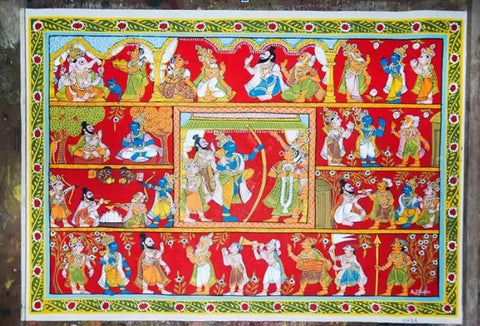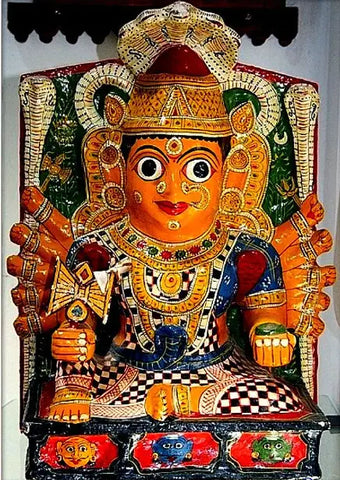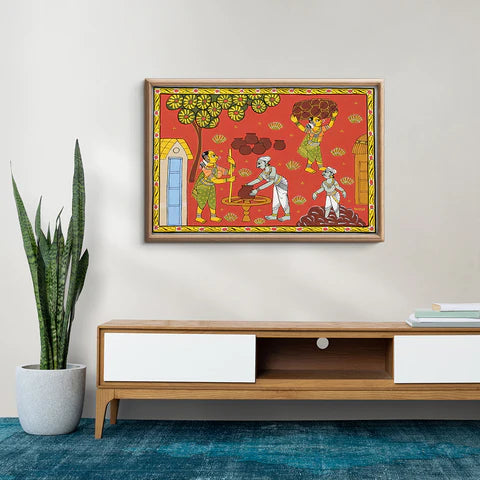India is a truly diverse country and despite having a plurality of cultures it never really feels distant. Every folk art culture has a story to tell and there is a very unique way of conveying them. Such is the case with the Cheriyal Scrolls from the state of Telangana!
Telangana is mostly popular for Hyderabad and Secunderabad and has some of the best cities in India. But the state has a deep, rich history which is important in Asian artistic traditions. Going forward in this blog we will learn about the Cheriyal paintings of Telangana and some interesting facts about Cheriyal scroll painting history.
What are Cheriyal Paintings?
Cheriyal Paintings of Telangana are a form of Nakashi art which is widely practised in Siddipet, Jagtial, and Nirmal districts of Telangana. It is a form of visual storytelling through illustrations on scrolls. Cheriyal scrolls are more analogous to an ancient version of a comic book with mostly religious and folklore narratives.
Cheriyal Painting of Telangana is characterised by bright vibrant colours like red in the background. These brilliantly hued Cheriayl paintings received Geographical Indication Status in 2007 by the Government of India.
Cheriyal Scroll Paintings History and Origin
Cheriyal scroll originated in the Cheriyal village of Telangana which is how it got its name. The roots of the Cheriyal scroll painting are a bit convoluted and there have been claims that art has its roots going back as far as the 5th century. The scroll painting draws heavily from Deccani and Kalamkari scroll illustrations, the earliest identified painted scrolls in Telangana can be traced back to 1625 under the rulership of Goloconda’s Qutub Shahis. Cheriyal paintings of Telangana also resemble 12th-century Kakatiya paintings.
Cheriyal Scrolls have been in public view as well! You can find them at Pillalamarri Temple and Tripurantaka hill temple. Cheriyal Paintings draw a heavy reference to temple art from Andhra/Telangana.

Notable Themes and Narratives found in Cheriyal Paintings of Telangana
Cheriyal illustrations usually adapt stories from Hindu mythological texts such as Mahabharata, Ramayana, Krishna Leela, Markandeya Purana, Garuda Purana, etc. It uses a visual aid to tell stories like Pattachitra. Cheriyal artists draw the artwork on a long vertical cloth and then wrap it up in a scroll, giving its name - Cheriyal Scroll. Traditional folk singers would go on to use these scrolls to recite the stories in the scroll. The recitation is done with musical instruments such as tabla, mridangam, etc. to make it entertaining.
Cheriyal Paintings have a rich cultural history which includes musical performances along with its artwork. However, they do have another societal significance. Cheriyal Scroll paintings were used not only as artwork but also as a means to orally educate the masses. These traditional stories were supposed to imbue the public with significant moral virtues. The Cheriyal Scroll is often made in several panels based on the architectural bodies and their caste lineages. It is a very important aspect of their painting. The narratives used in Cheriyal scroll paintings are mythological and supernatural.
Stories told through Cheriyal scrolls are extremely diverse and vary based on the locale. Since these story recitals happen in a very provincial setting, it tends to take the characteristics of the geographical area. For example, people from the Padmashali caste perform Markandeya Puranas. The Cheriyal artistry is more than what you see on the surface! It even includes making masks and dolls. Just like the scrolls, these are also a vital part of their storytelling legends.
 (in the picture- Sculpture of lord Vishnu seated with Shesh Naga in Cheriyal artistry)
(in the picture- Sculpture of lord Vishnu seated with Shesh Naga in Cheriyal artistry)
Procedure & Materials Used for Making a Cheriyal Scroll Painting of Telangana
Cheriyal is a 400-year-old art form of southern India. Cheriyal artists used to build most of their art supplies by hand using natural resources. Making a canvas for Cheriyal painting is quite an intricate process. It is started with treating Khadi cotton with a mix of rice starch (maad bhaat), white mud (suddha matti), and also a paste made of of boiled tamarind seeds. Gum water is added on to the paste. It is done in a careful way where every coat is meticulously dried before the application of the next one!
After the canvas is prepared the artist draws a well-defined outline using a brush. The qualities of the outline show the experience of the artist. And then the final process of filling the outline sketch with colours.
Cheriyal paintings use a certain approach in its colour schemes. Every colour implies a certain meaning and holds some symbolism attached to it. The background is usually painted in bright red which helps in highlighting the figures in the painting. Blue is used to depict the face and skin of Gods and yellow for Goddesses. Darker shades like brown are used to denote demons and pink skin tones for humans.
Once the painting is complete, leaves and flowers are drawn on the border as a finishing touch.
Legacy of Cheriyal Painting of Telangana
Modern forms of entertainment such as TV, Cinema, and more recently OTT platforms have faded the practice of Cheriyal scroll paintings and recitals entirely. The practice now solely stays in the hands of the craftsmen who keep up the familial traditions alive. Several families have kept the art form alive.
Some of the Popular Cheriyal artists are
- D. Pavan Kumar,
- D. Vaikuntam,
- D. Venkataramana
- Venkata Ramiah Nakash and his descendant Saikiran Dhanalakota
These folks and many more are working with their families to keep the Cherial Scroll Painting alive.
It also helps that Cheriyal scroll painting of Telangana has GI (Geographical Indication) status in 2007. The art form has received Intellectual Property Rights Protection (IPRP) with a specified geographical location attached to it. This has helped improve the visibility of the Cheriyal paintings but also gave them added prestige.
Where is Cheriyal Scrolls Art today?

As winds of change blow, Cheriyal scroll painting has seen a considerable change in how it is presented. Long-winded stories are now cut short as there is no congregation for recitals. As per Cheriyal scroll painting history, the illustration manuscripts could be as large as 60 feet with over 50 panels. The art form has moved on from showcasing whole stories to depictions of solo events, episodes, or just characters in a single panel. The artists have now adapted to the requirements of a modern market and now mostly create scroll paintings for easy-to-carry and displayable wall art and framed paintings.
A chunk of traditions has been left behind to abide by the commerciality of it.
Conclusion
Like most folk art across India, Cheriyal paintings have found a special place and have continued to thrive. Generations of knowledge have been preserved and improved upon, and a heritage that was maintained has now become more widely available as people learn more about it. Cheriyal scroll paintings have survived and have managed to inspire folks across the globe. Given that in 2007, the Cheriyal painting achieved both IPRP and GI status; its legend is here to stay.
FAQs
-
Which painting is famous in Telangana?
Cheriyal scroll painting is famous in Telangana because of its nativeness to the state.
-
Which district in Telangana has scroll paintings?
Siddipet is the main district where scroll paintings seem to have a stronghold in Telangana, but it is also practised in Nirmal & Jagtial districts.
-
When and where did the Cheriyal Painting originate?
The origin of Cheriyal Scroll painting can be traced back to the 5th Century. The earliest identified painted scrolls in Telangana are believed to be found around 1625 under the rulership of Goloconda’s Qutub Shahis.
-
What is the theme of Cheriyal Painting?
The most common narratives of Cheriyal Paintings are mythical. It draws its stories from epics such as Mahabharata and Ramayana, among others.
-
What materials are used in Cheriyal Scroll Painting?
For Cheriyal canvas, a Khadi cotton cloth is coated in a thick paste of rice starch, white mud, boiled tamarind seed paste, and gum. The process takes a couple of days.
Colours are usually made of natural dyes.
-
What Colours are used in Cheriyal painting?
Cheriyal scroll paintings have a certain colour code. They are
- Blue for Gods
- Yellow for Goddesses
- Darker shades such as brown and black for demons
- Pink for humans
 Verified Purchase
Verified Purchase



















Imran
Liquid error (sections/custom_blog_posts line 652): The format option 'month_day_year' is not a supported format.
Iam looking for the painting 6 *5